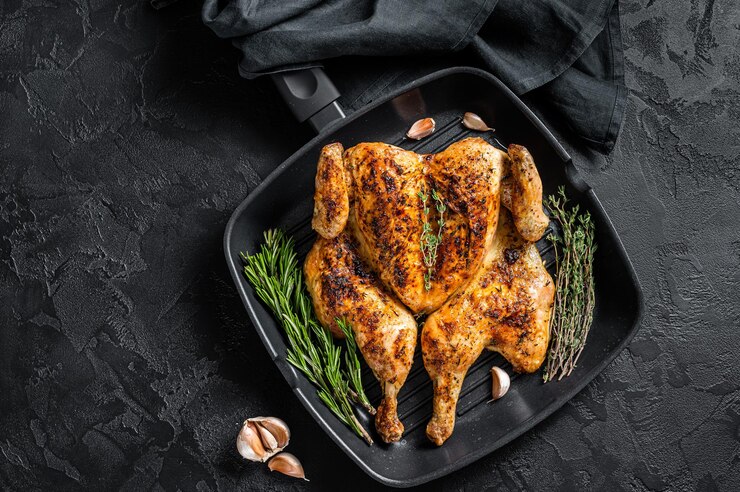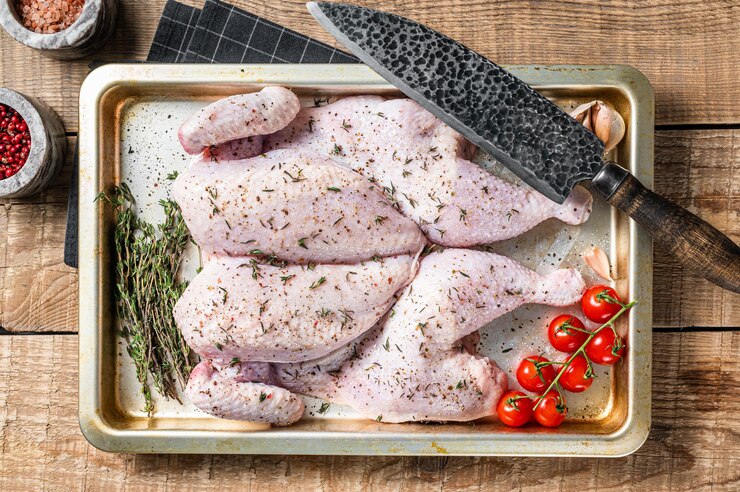Learning how to spatchcock a chicken can be tricky, but it’s not complicated! This easy method is excellent for those who love to cook, and it’s a great way to get the most flavorful and moist chicken possible. The most important part of roasting a bird is timing, and spatchcocking a bird will ensure that all the breasts are cooked equally. The butterflying technique entails removing the backbone from a chicken, flattening the whole bird, and slicing the backbone. The process is straightforward and will produce perfectly roasted leg and breast meat. In addition to creating a delicious jus, the backbone can be used for various cooking purposes. The process can be performed on poultry, from turkey to fish.
Before cooking, spatchcocking is a crucial part of the chicken preparation process. By removing the backbone, you can easily access the cavity and exterior of the bird, making the entire process much more manageable. This method works on poultry, from ducks to geese, and requires only a pair of kitchen scissors and poultry shears. Once you have the necessary tools, spatchcocking a chicken should be as easy as pie. You need to carefully cut open the chicken’s backbone using the poultry shears during the process. The breasts should be facing up. When you’re done, the breasts should be spread open, and you should hear a crunching sound. The backbone is usually kept for stock or broth, and the rest of the parts can be used for cooking. So, how to spatchcock a chicken?
What Is Spatchcocking?
Spatchcocking, also known as butterflying, is a method of cooking a whole chicken in which the backbone is removed, and the breastbone is broken. “A chicken split and grilled usually immediately after being killed and dressed,” according to the dictionary definition. However, whether you want to grill it or not, spatchcocking a chicken is a process of removing the backbone of a complete chicken so that it lays flat. We enjoy spatchcocked birds roasted, grilled, and cooked over an open flame—there is no incorrect way to cook a spatchcocked chicken, in our opinion.
How To Spatchcock A Chicken?
Place the chicken on a large cutting board after removing it from its package. Place the chicken breast-side down on the board, neck facing you, and pat dries using paper towels.
Cut down one side of the bird spine, separating it from the ribs, use good-quality kitchen scissors or poultry shears in one hand. To avoid removing any surplus meat, cut close to the spine. Continue cutting approximately 34% along one side of the spine, then repeat on the other side. Hold the spine for leverage and cut on both sides to thoroughly remove it. If you’re having trouble, turn the bird so the tail faces you and cut from the other side. We’re all set to roast, and it’s that simple! For turkey, you use the same approach (or any poultry).
Steps
- Get the chicken ready. To make it easier to handle, pat the chicken dry with paper towels. Remove any giblets or water from the chicken’s inside. Place the chicken breasts on a large cutting board, breast side down.
- The backbone must be removed. Remove the backbone using a sharp knife, kitchen shears, or poultry shears. Cut up one side of the backbone, starting at the tail end. Then do the same thing on the other side to get rid of the backbone. (Save the remainder for chicken stock.) You’re ready to begin spatchcocking a chicken once you’ve removed the backbone and wingtips. After the chicken is flattened, it should be trimmed, and then the breasts should be positioned on the backbone. The chicken should be free of bones and a spit-free, bone-free bird. The backbone and wings can be used in stock recipes and broths.
- The breastbone should be broken. Turn the chicken over so the breast side is facing up and the inside is on the cutting board. Firmly press down on the center of the breastbone with the palm of your hand. The breastbone should break, and a crack should be heard. If not, try again, increasing the pressure until the breastbone is broken.
- Make the chicken flat. Press down on the chicken with your hands to get it as flat as possible. Remove the wing tips with a sharp knife or shears, as they tend to burn when roasting. (Save the remainder for chicken stock.) Cover the wing tips with aluminum foil or tuck them underneath the breasts during cooking if you want
Tips For Making Spatchcock Chicken
- Use a 2-4 pound entire chicken for this recipe. This spatchcock technique is designed for a bit of bird; anything more significant will make cutting the backbone harder.
- Allow 30 minutes for the raw chicken to come to room temperature before roasting. This ensures that the entire chicken is at the same temperature for equal browning.
- Cut the backbone with powerful kitchen shears. If you use scissors instead of a knife, make sure they are sharp, making cutting much more straightforward.
- To prevent the chicken breast from drying out, don’t overbake it. Like 165 degrees Fahrenheit is the perfect temperature for cooking chicken, keep in mind that the temperature will continue to rise while the chicken rests outside the oven. As a result, most sites I’ve read say to take the chicken out when the internal temperature reaches 160 degrees Fahrenheit.
Is It Possible To Spatchcock A Chicken With Just a Knife?
Yes, you certainly can. Make use of a big, sharp knife. Place the knife’s tip on one side of the backbone in the center of the chicken, press it down, and then firmly bring the knife down along one side of the spine in one stroke, cutting through. Repeat on the other side of the backbone until you’ve cut down one side. Rep on the opposite side. Place the chicken breast side up on a cutting board and cut into the neck cavity with a knife. Cut downward to separate one side of the spine from the body with the tip of the knife coming through at the opposite end of the bird.
Why Should You Have To Spatchcock A Chicken?
Do you know why you should spatchcock a chicken? Here are several compelling reasons to spatchcock that bird:
Cooking time is reduced: a standard whole chicken takes an hour and a half to roast in a 450°F oven, and a spatchcocked whole chicken takes half the time and is done in approximately 40 minutes. Cooking is more even: it cooks swiftly and evenly because the chicken is spread out in a flat, equal sheet, and more surface area is exposed, making it easier to season the bird in every nook and cranny.
What Is The Benefits Of Spatchcocking?
- There’s no need for trussing or kitchen twine. Does anyone enjoy trussing poultry? No, that is not the case.
- All of the chicken skin is exposed to the oven’s heat since the chicken lays fully flat. This results in very crispy, caramelized skin all over the chicken.
- Timing is the most challenging aspect of roasting a chicken. White meat (breasts) cooks and dries up more quickly than dark meat (thighs) (legs and thighs). It’s challenging to avoid overcooking the breasts while the legs finish cooking in a standard trussed chicken. This procedure produces even cooking in the breasts and legs since spatchcocked chickens lay perfectly flat.
- Spatchcocking reduces roasting time significantly. It’s gotten to the point where you can roast a chicken on a hectic weeknight. It took just over an hour to roast this 5-pound chicken, and it would take about 1 hour and 45 minutes to cook a standard trussed chicken of this size.
- Because spatchcocked fowl cooks faster (because of the increased surface area and heat exposure), you can roast at higher temperatures, resulting in wonderfully golden, crispy skin.
- Carving is easier with scratch-cocked poultry. Because of the shape of the chicken, removing the legs and breasts from the bone is much easier.
- Because the poultry lays flat, it’s easier to season uniformly. You don’t have to be concerned about not being able to reach every nook and cranny of the cavity, and everything is out in the open.
Conclusion
The breastbone is flexible and can be opened and flattened. Place the chicken’s legs and wings facing out. With the backbone removed, you can now remove the backbone. Then, you’ll have to trim the wings and wingtips. Some chickens will have trimmed wings, but some will still have intact wingtips. In these cases, you’ll want to cut them off and place them under the breasts to avoid burning when you’re ready to roast a chicken, prep it properly.
It would help if you prepared it by preheating the oven to 450 degrees. After you’ve preheated the oven, remove the breasts and thighs from their cavities. Afterward, find the backbone and breast meat. Once the chicken is fully cooked, you’re ready to serve it with your favorite meal. First of all, you need a good quality pair of kitchen shears. Using these shears, cut through the chicken’s spine. Then, rotate the chicken so that the tail is facing up. When the chicken’s legs are spread, it’s ready for roasting. The resulting bird will be tender and crispy. The process of spatchcocking a bird is quite simple, and it can be done with any poultry.

